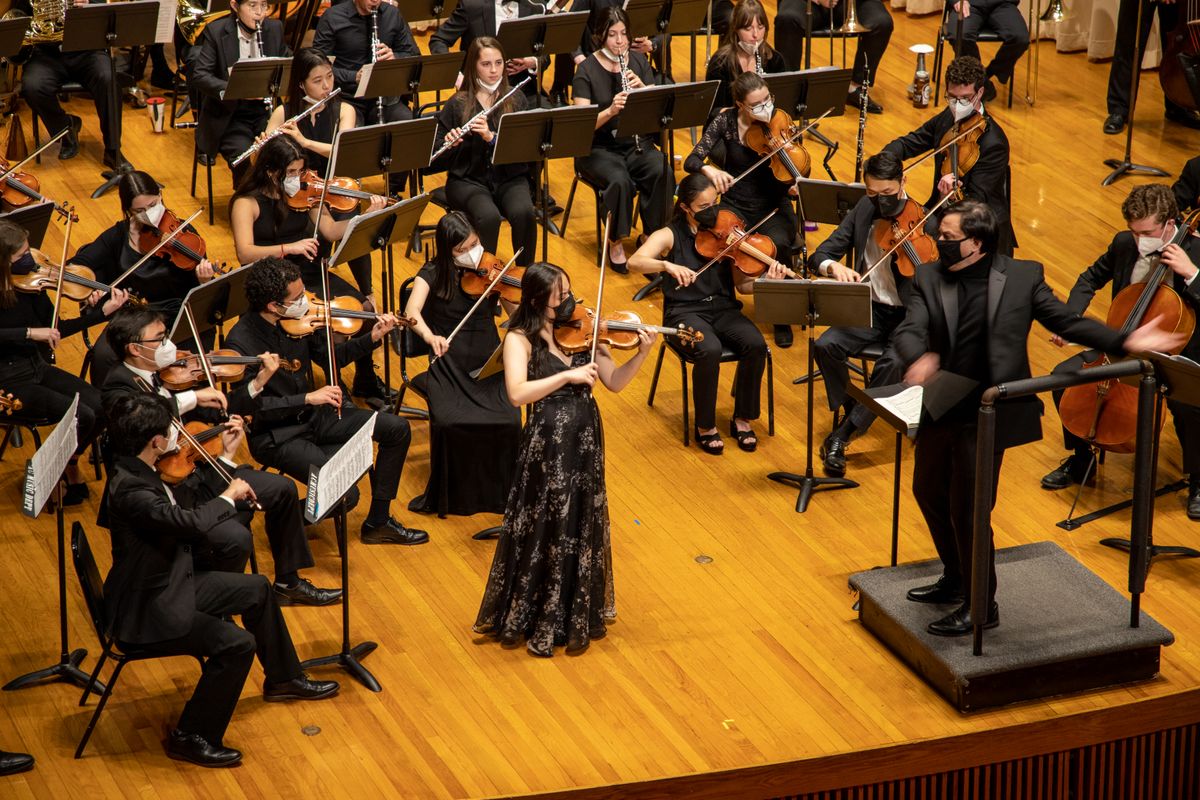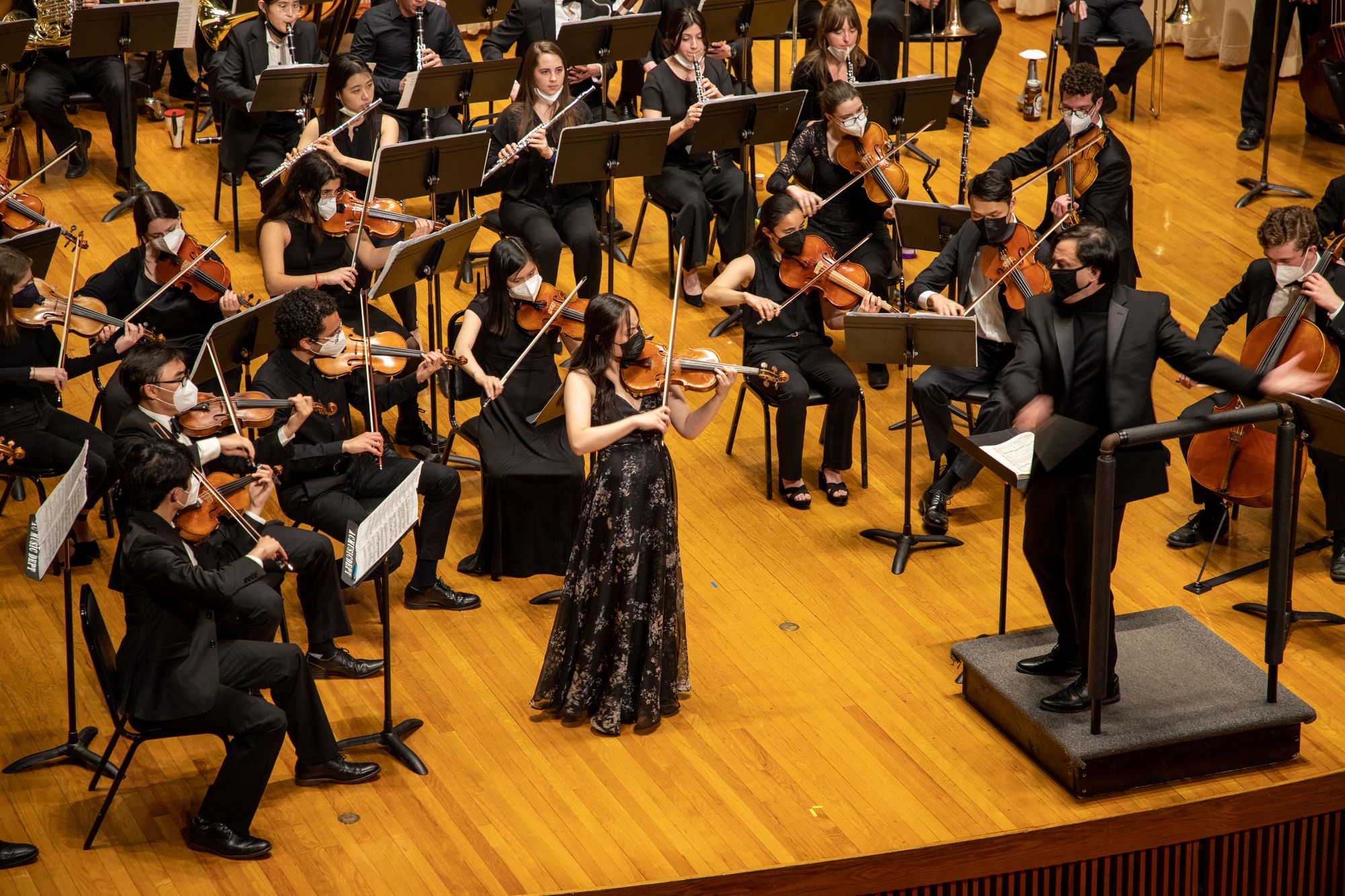The Symphony Signing Off: ASO’s Season Finale
The Amherst Symphony Orchestra performed their last concert of the season last Saturday. Managing Arts and Living Editor Madeline Lawson ʼ25 reviews the performance, which featured a concerto from violinist Marie Leou ʼ22.


On May 7, the Amherst Symphony Orchestra (ASO) performed their final concert of the season. The program, dedicated to President Biddy Martin, consisted of a Sibelius concerto featuring violinist Marie Leou ’22, and “Titan,” Mahler’s Symphony in D Major. The audience was packed, and many community members, including Martin, gathered to enjoy the orchestra.
An anthropology major who is planning on applying to medical school next year, Leou has been a member of the ASO for all of her four years at Amherst. Leou’s concerto performance was initially set to be performed in March, but was postponed to the season finale due to rising Covid cases. The three-movement concerto began with an ominous introduction: a hum from the orchestra, met by a single, wailing note from Leou’s violin. According to San Franciso Symphony Program Writer Michael Steinberg, Sibelius had intended for the opening note of the concerto to be incredible. Leou delivered, producing a sound that pierced the room and powerfully drew listeners in.
Throughout the performance, Leou maintained a commanding presence on stage. She executed technical runs with impressive speed while still conveying emotion throughout. She produced so many chords that it was hard to believe there was only one violin playing. The orchestra complemented her playing beautifully, creating a strong support for Leou to flourish alongside. In the second movement, she was so in sync with the orchestra that they almost echoed one another.
The movements contrasted each other, yet possessed similar tones that ultimately united them as complementary components of one great piece. The first movement was melancholic, growing into a rousing and bitter swell from the orchestra, and the second began with a woodwind melody and bouncing arpeggios from Leou. The third and final movement was the most technically advanced — Leou produced astronomically high notes and bounding leaps above a rousing symphony, while still playing delicate grace notes with emotion.
“I have been working on [the piece] by myself for about a year and a half now,” Leou said. “The summer before this year, the conductor [Mark Swanson] asked me to play the concerto with the orchestra. We usually have about five or six rehearsals with the orchestra.”
Conductor Mark Swanson noted that the concerto is “wicked to coordinate with the orchestra.” It’s difficult to believe that such a smooth performance could be mastered with so few joint rehearsals.
After intermission, the orchestra performed its second piece of the night, “Titan,” a four-movement symphony. “Mahler’s First Symphony is a large expanse with virtuosic passages as well as very subtle, chamber-like, delicate sections that also need careful and detailed preparation,” Swanson explained. With a run time of over an hour, it’s impressive that the orchestra maintained their vigor throughout the performance, playing with as much strength at the end of the fourth movement as during the first chilling note from the violins. A two-note melody made its way around the orchestra, growing stronger until the music exploded. It was a gradual buildup, one that felt inevitable yet exciting.
The second movement was more playful and jaunty, with variations on a melody throughout the trumpets. It employed more percussion than the previous movement. Heavy timpani rang throughout, and it ended with a cymbal crash. The third movement featured a soulful double bass and timpani, and the fourth movement was the longest, beginning with an energizing roar from the violins and cellos. It featured incredible amounts of power from each section and ended with a satisfyingly definite conclusion.
Reflecting on the season, Swanson said, “I’m exceedingly proud of the six in-person concerts the ASO has performed this academic year; it was unusual in that it featured eight students as soloists in concertos. We also performed four large-scale symphonic masterpieces by Dvorak, Elgar, Beethoven, and Mahler.”
Leou added, “I’m really thankful to have been a part of the music community at Amherst. It’s been a really great experience. I’d like to say thank you to all my professors, especially the music professors who have been really supportive even though I’m not a music major, and people in the music community and all the people in orchestra. Also to my violin teacher, Sarah Briggs. She’s been a really great help.”
The ASO’s first in-person season since Covid was a rousing success, and I am confident that the ASO will continue to provide fantastic professional-level symphonies for years to come.





Comments ()